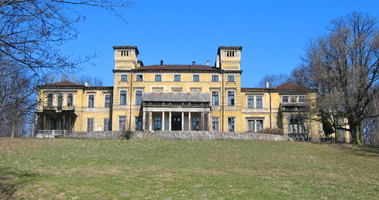We have had the great good fortune to create commissioned portraits of two exceptional palaces, the first in Lviv (Ukraine) and in now in Paris, legacies of the renowned Potocki family, ancient and influential Polish nobles, comparable to the Stroganoffs of Russia and the Rohans of France. (Below, Jacques-Louis David's famed equestrian portrait of Count Stanisław Kostka Potocki, which the painter later recycled for Napoléon.)
The family's history is inextricably enmeshed with that of Poland, and unfurls a staggering procession of statesmen, generals and magnates stretching back to the 10th century. Until the calamity of World War II befell Poland, the family's several branches held over forty major town palaces, châteaux and manors and controlled over a quarter of the country's territory. In comparison, the French Bourbons appear dilettantes in the domain of architectural patronage. Today former Potocki properties are found from Georgia and the Ukraine in the east to Paris in the west, and several notable examples are illustrated at the end of this post.
Above is our freshly completed elevation of the Hôtel Potocki, built in 1884 by the architect Jules Reboul, which stands at 27 avenue Friedland in Paris's 8th arrondissement. The hôtel was among the grandest town palaces built in Paris in the late 19th century, designed in the neo-Louis XIV style that defined the era, its central, square-planned dome evoking the Tuileries palace and its column screens recalling the Enveloppe of Versailles.
The Potocki family was admired in Paris for their remarkable generosity to their countrymen and for their extensive charity works; for example, they erected the church of Corpus Christi on donated land adjoining the hôtel during its construction. The dependencies, formerly located on rue Châteaubriand and today destroyed, were renowned for their stables, which featured 38 mahogany horse stalls with rose marble watering troughs and some fifty grooms on permanent call.
Heirs sold the hôtel to the Paris Chamber of Commerce in 1923, which carried out two campaigns of renovations, the second in the early 1930s employing the era's foremost talents: renowned art-déco decorator and ébeniste Jacques-Émile Ruhlmann, the silversmiths Christofle (which executed the remarkable monumental bronze door seen in the detail at top), the sculptor Joseph Bernard and the interior decorator Jules Leleu.
The watercolor itself is a vast miniature, well over a yard long, and required months to execute. One number stands out: 1364, which is the number of window panes drawn and painted.
Below is our earlier watercolor depicting the former Potocki Palace in Lviv, today a residence of the president of the Ukraine.
Other former Potocki residences include the "Versailles of Poland," Wilanów Palace,
the beautiful Łańcut Castle near Rzeszow, Poland,
and its handsome orangerie,
the neoclassical jewel of Natolin on the outskirts of Warsaw,
the Potocki Palace, Warsaw,
the magnificent neoclassical Potocki Palace in Tulchyn, today the Ukraine,
the Potocki Palace in Radzyń,
the Italianate Krzeszwicke Palace, today in disrepair.
Again, just a sampling of a remarkable architectural heritage.













What a magnificient legacy indeed dahhling.. such beautiful magnificient architectual gems. What a shame so many are failing into disrepair.
ReplyDeleteYour highness, the worst off are those estates in the Ukraine, which cannot afford to restore them. Georgia is carrying out some work and Poland has been quite diligent in conserving their architectural heritage.
ReplyDeleteDear Sir,
ReplyDeletethe last photograph shows the Grocholski Palace in Woronowica. Please consult Roman Aftanazy's "Dzieje rezydencji na dawnych kresów rzeczypospolitej" (The history of the residences in the old borderlands), vol. 10.
Yours sincerely
G.v.H.
Thank you very much for the correction; the image has been removed from the post. Much appreciated!
ReplyDelete